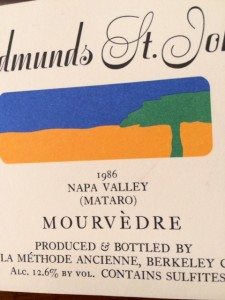30 Days of Rosé | #09 | Bone Jolly | Gamay Noir Rosé | El Dorado County | 2016
Rustle your bones and try a lively Rosé from one of the highest (elevation) California vineyards!
From edmundsstjohn.com:
 Bone-Jolly Gamay Noir Rosé:
Bone-Jolly Gamay Noir Rosé:
The 2014 vintage in California was the second in a row substantially affected by severe drought. Despite very limited irrigation in the vineyards we work with, the available soil moisture was so greatly diminished by early August that the vines ripening process was accelerated before much sugar had accumulated in the grapes. Fortunately the weather stayed pretty even, and the early and rapid harvest produced exceptionally high quality fruit. Alcohols were low, acidity was strong, and energy and freshness were hallmarks of the resulting wines. Case in point: our 2014 Bone-Jolly Gamay Noir Rosé
FRUIT SOURCE:
Witters Vineyard At 3400’ elevation, above Camino, in the eastern reaches of the Apple Hill region. Soil is Aiken series vocanic clay-loam. The property was, for many years, a pear orchard, but in 2000 Bob Witters followed Ron Mansfield’s recommendation, and planted four acres of Gamay for us. Since 2011, we’ve used the Gamay from Witters exclusively for rosé.
WINEMAKING NOTES:
Picked August 18th at a bit under 21 Brix, with a 3.28pH. Grapes were de-stemmed into the press, and pressed immediately. Juice fermented very cool at 55-60F, till dryness at mid-September, at which point the malo was blocked.
WINEMAKER’S TASTING NOTES:
Pretty pale-pink color with a little blue around the rim. Very fresh, penetrating nose . Juicy and precise on the palate, mouth-watering, showing lot of depth. The finish is long, and clean. This is already really versatile at the table, as always. Alcohol is 12.6%
Witters Vineyard:
Before 2000, Bob Witters’ property was planted to Bartlett pears, for quite some time. But by 1999, the pressure of global economics drove the market price for Bob’s pears so low that it didn’t make sense for him to keep farming them. The market for wine grapes, on the other hand, was expanding, and Bob had a conversation with Ron Mansfield about putting in a vineyard to replace his pears.
Since Edmunds St. John had been working with Ron at that point for a dozen years, we spoke about Bob’s site, and it seemed like it might be a really good site for Gamay, a grape that had been on our radar for some time. Ron conferred with Bob, and in the Spring of 2000, four acres were planted to Gamay, the first planting of real Gamay in California in a generation!
Witters is situated at 3,400 feet elevation, making it one of the highest vineyards in California. The soil is volcanic clay-loam, and the land slopes gently down to the North. At that elevation, temperatures are generally pretty mild, and nights can be quite cool. The risk for frost in the Spring is fairly high, and there have been a couple of years where crop losses were substantial.
About:
Winemaking isn’t Rocket Science; it’s an ancient, relatively straightforward process that should yield, in any wine, a precise expression of the vineyard and the season that produced it.

Given grapes farmed attentively, with vines in optimal balance, the key to producing a wine that is an elemental, unfettered expression of its origin in place and time is being able to pick at that point closest to the moment when the flavor in the grapes has come fully into focus, a moment that is usually also when that flavor is most energetic. The window is fairly small. After the grapes are picked, I’m trying not to add or subtract anything from the raw material.
In 1987 a wine grower from a venerable domaine in Southern France visited our cellar, and tasted a number of wines from the harvest just past. When he came to the one from my favorite vineyard his response was dramatic: he raised his nose from the glass, slowly rolling his eyes upward in reverie. He sighed, and whispered, “la terre parle” (the earth speaks). If I have done my job well, when you taste our wine you may be similarly affected; this is a voice one longs to hear.
It is our goal to produce wines of the highest level of quality, integrity, and authenticity, the hallmarks of which are balance, nuance, and elegance, wines that express their origins in place and time, wines through which “the earth speaks” in a clear and strong voice. As a winemaker, for me there is no other voice.
After three decades, there are still many people who have not heard of us, but of those who have, most of them seem to say “Oh, yes; Edmunds St. John–they make great wines!”
Steve Edmunds, 2015



